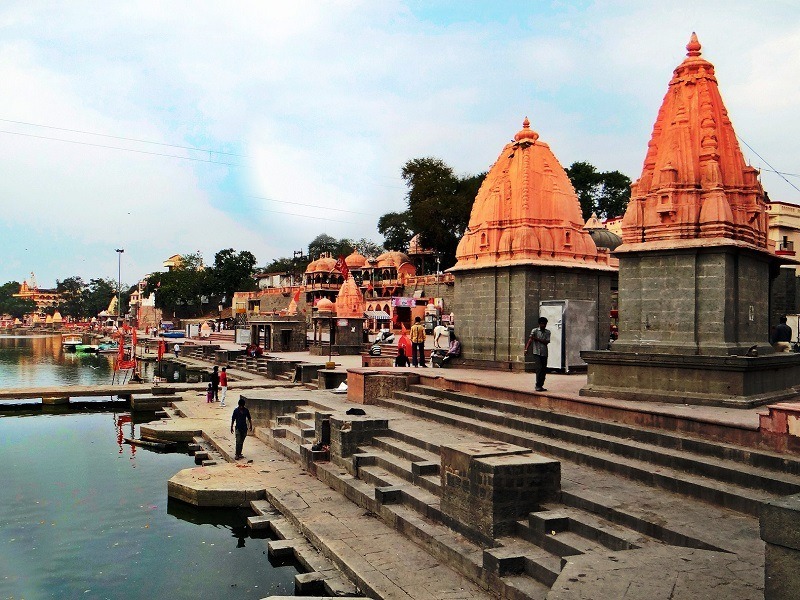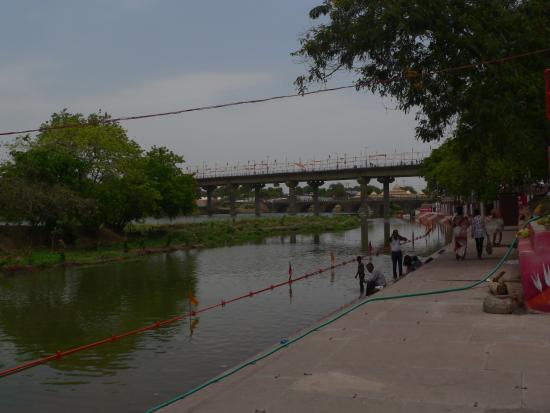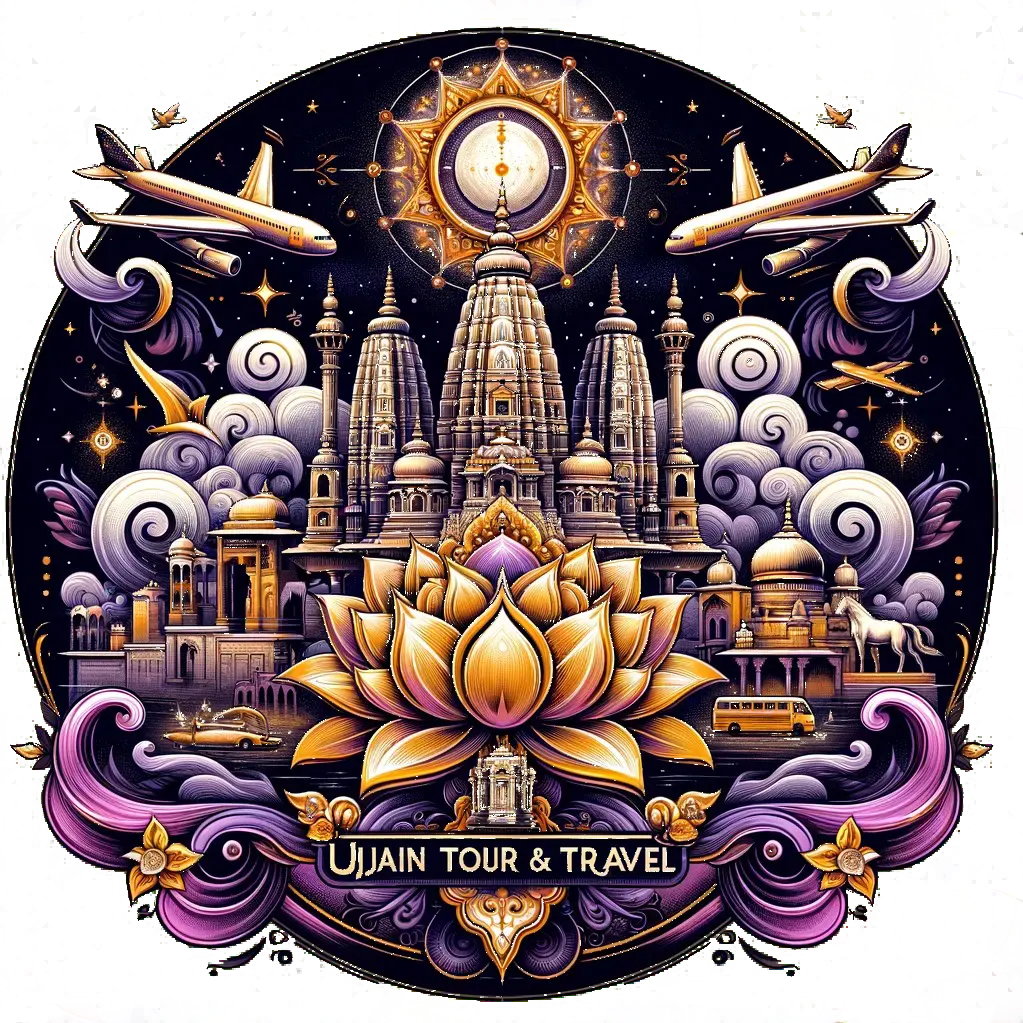Ujjain's soul is intrinsically linked to the Kshipra River, its sacred waters flowing through the heart of the city. This spiritual connection is beautifully manifested in the numerous ghats (bathing steps) that line the riverbanks. Here, we delve into the significance of three prominent ghats – Ram Ghat, Triveni Ghat, and Gangeshwar Ghat – offering a glimpse into the city's vibrant religious life.
Ram Ghat :
Ram Ghat, named after Lord Rama, the revered Hindu deity, is one of the oldest and most prominent ghats in Ujjain. Legend narrates that Lord Rama himself visited this ghat during his exile along with his wife Sita and brother Lakshmana. The ghat holds immense significance for devotees who believe bathing in the Kshipra's holy waters at Ram Ghat washes away sins and brings blessings.

Importance :
Ram Ghat is a hub for daily rituals and religious ceremonies. Early mornings witness devotees performing aarti (prayer rituals) and taking holy dips in the Kshipra. Throughout the day, pilgrims chant hymns, offer prayers, and float diyas (oil lamps) on the river, creating a mesmerizing spectacle. During festivals like Diwali and Makar Sankranti, the ghat comes alive with vibrant celebrations, drawing throngs of devotees seeking blessings.
What to Expect and Enjoy :
A visit to Ram Ghat offers a glimpse into the heart of Ujjain's spiritual life. Witnessing the daily rituals, the fervent prayers of devotees, and the serene atmosphere can be a deeply enriching experience. Participating in a puja (worship ceremony) or simply observing the proceedings allows you to connect with the city's religious traditions. The ghat also provides a picturesque setting for photography, capturing the interplay of light, water, and faith.
Triveni Ghat :
Triveni Ghat, named after the confluence of three sacred rivers – the Kshipra, the Saraswati (considered a sacred underground river), and the invisible Gambhira – is another revered bathing spot in Ujjain. The confluence of these rivers is believed to possess immense spiritual power, attracting devotees seeking purification and blessings.

Importance :
Triveni Ghat holds immense significance for pilgrims, particularly during the Kumbh Mela, a massive Hindu pilgrimage and festival held in Ujjain every 12 years. During the Kumbh Mela, millions of devotees gather at Triveni Ghat to take a holy dip in the Kshipra, believed to absolve them of sins and grant spiritual liberation. Even on ordinary days, the ghat witnesses a steady stream of pilgrims performing puja rituals and offering prayers.
What to Expect and Enjoy :
A visit to Triveni Ghat offers a unique experience, especially during the Kumbh Mela. Witnessing the sheer scale of the gathering, the fervent devotion of the pilgrims, and the vibrant atmosphere is truly unforgettable. However, even on regular days, the ghat offers a serene escape from the city's bustle. The soothing sound of flowing water, the chanting of hymns, and the sight of colorful prayer flags create a sense of peace and tranquility.
Gangeshwar Ghat :
Gangeshwar Ghat, named after Lord Shiva, is another important ghat on the banks of the Kshipra. It is known for housing a unique temple complex dedicated to Lord Shiva. The complex houses 12 jyotirlingas (symbolic representations of Shiva's radiant light), each representing a different manifestation of the deity.
Importance :
Gangeshwar Ghat holds significance for devotees of Lord Shiva. The presence of the 12 jyotirlingas allows pilgrims to pay homage to various aspects of Shiva's divine power. The ghat is also associated with the legend of King Bhagiratha, who brought the sacred Ganges River down from heaven to Earth. Devotees believe bathing in the Kshipra at this ghat is akin to bathing in the Ganges, granting them immense spiritual merit.
What to Expect and Enjoy :
A visit to Gangeshwar Ghat offers a unique opportunity to explore the temple complex and pay respects to the 12 jyotirlingas. The serene atmosphere of the ghat allows for moments of reflection and introspection. Engaging a local guide can provide valuable insights into the significance of each jyotirlinga and the legends associated with the ghat. The ghat also offers a picturesque setting for photography, capturing the intricate temple architecture and the serenity of the Kshipra River.
Explore Other Attractions in Ujjain
Ujjain is a city full of history, culture, and spirituality. After exploring this site, make sure to visit these other remarkable attractions:
- Sandipani Ashram: A sacred site where Lord Krishna, Balram, and Sudama are believed to have received their education. The ashram's peaceful surroundings make it a spiritual haven.
- Kaliadeh Palace: An architectural marvel on the banks of the Shipra River, showcasing Persian-style design and offering a glimpse into Ujjain's royal history.
- Vikram University: Named after the legendary King Vikramaditya, this renowned institution is a landmark of education and culture in Ujjain.
- Triveni Museum: Home to exquisite artifacts, sculptures, and exhibits that narrate the rich history and art of Ujjain.
- Jantar Mantar: An ancient observatory that highlights India’s advanced astronomical and timekeeping expertise.
- Bhartrihari Caves: Explore the legendary caves associated with Bhartrihari, known for their historical significance and tranquil environment.
